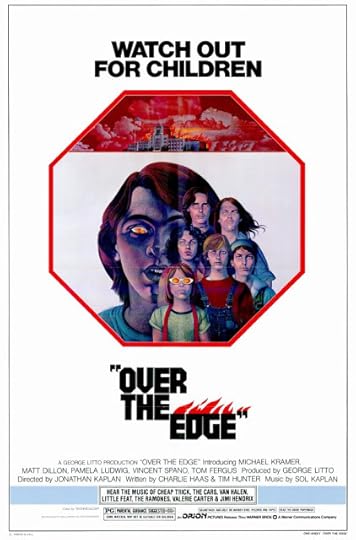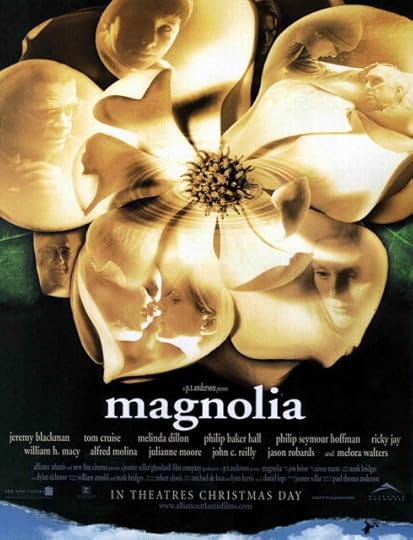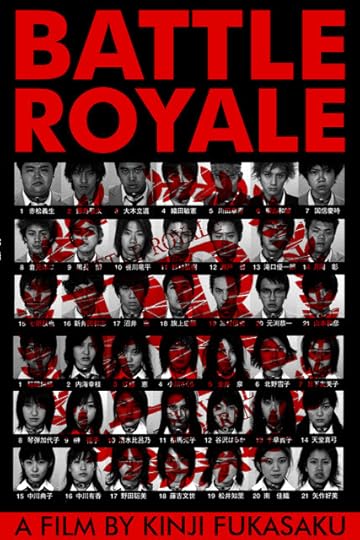Movies I Watched in November, Part 2
Here's the eagerly awaited (?) second installment of the movies I watched in November...
 I’d somehow managed to miss this 1979 apocalyptic teen film all these years, reading rave reviews (especially one in Danny Peary’s seminal book, “Cult Movies 2”) but never getting my hands on a copy. Thankfully, Turner Classic Movies came through once again, airing a widescreen, uncut, hi-def copy late one night. Even more thankfully, the movie lived up to – and even exceeded – my considerable expectations. It’s one of the darkest, most compelling films about teens I’ve ever seen, focusing on the troubled (to put it mildly) youths of the planned community of New Granada. The adults, in an effort to maximize profits, scuttle plans for a movie theater and roller rink, forcing the bored kids to congregate in a bare-bones Quonset hut, which only cranks up the tension. When the thrills of the Quonset hut aren’t enough, our heroes (including a very young Matt Dillon) resort to the usual: vandalism, fights, drugs and some unnerving awkward gunplay. The pressure keeps building and building until one night, when all the adults gather at the school to discuss the “youth problem,” the teens lock them inside and blow up virtually every car in the parking lot. It’s like the climax of “Rock ‘N Roll High School” played seriously, and it manages to be frightening and freeing all at once. Definitely check this one out if you get a chance – it puts the tepid teen movies of John Hughes to shame.
I’d somehow managed to miss this 1979 apocalyptic teen film all these years, reading rave reviews (especially one in Danny Peary’s seminal book, “Cult Movies 2”) but never getting my hands on a copy. Thankfully, Turner Classic Movies came through once again, airing a widescreen, uncut, hi-def copy late one night. Even more thankfully, the movie lived up to – and even exceeded – my considerable expectations. It’s one of the darkest, most compelling films about teens I’ve ever seen, focusing on the troubled (to put it mildly) youths of the planned community of New Granada. The adults, in an effort to maximize profits, scuttle plans for a movie theater and roller rink, forcing the bored kids to congregate in a bare-bones Quonset hut, which only cranks up the tension. When the thrills of the Quonset hut aren’t enough, our heroes (including a very young Matt Dillon) resort to the usual: vandalism, fights, drugs and some unnerving awkward gunplay. The pressure keeps building and building until one night, when all the adults gather at the school to discuss the “youth problem,” the teens lock them inside and blow up virtually every car in the parking lot. It’s like the climax of “Rock ‘N Roll High School” played seriously, and it manages to be frightening and freeing all at once. Definitely check this one out if you get a chance – it puts the tepid teen movies of John Hughes to shame.

Re-watched this 1999 Paul Thomas Anderson movie thinking we were doing an Out of Theaters podcast about it. That episode hasn’t happened (not yet, anyway), but I was glad I gave it another look. It’s a big, crazy, overly ambitious movie that, to be honest, is a bit of a mess at times, but it’s a glorious mess, the sort of thing you only get from a filmmaker drunk on both his own power and the power of cinema. Inspired by the music of Aimee Mann, “Magnolia” really feels like a symphony of sorts, with rising and falling movements and themes (in the form of characters, plotlines and dialogue) that echo and contrast with each other. It all builds to a frankly amazing climax, foreshadowed by the sequence when all the characters sing Mann’s “Wise Up” but really coming to life when, in a biblical event (hinted at by numerous references to 8:2 throughout the film) thousands of frogs fall from the sky. It’s a ballsy narrative move to say the least, but it works perfectly, releasing the almost unbearable tension that’s been building for the past two hours. The coda that follows is just-right, too ending the movie with a shot of a genuine smile from actress Melora Walters that acts as the perfect period to a movie that, until that quiet finale, has been a series of bold exclamation points.

Watched this one for the podcast ( listen here ) in ourattempt to cash in on the “Hunger Games” juggernaut. Now, I’ve only seen snippets of “The Hunger Games” movies as I’ve skidded past them channel surfing, but I think I can safely say that 2000’s “Battle Royale” is superior to that other (and later) kids-killing-kids movie in every way. For one thing, the scenes of “The Hunger Games” I have seen sugarcoat the carnage with blurry filmmaking, fast cuts and a general sense that Katniss (Really? Katniss?) isn’t some cold-blooded murderer. “Battle Royale,” on the other hand, starts the killing before the kids even leave the school, and as soon as they’re armed (with everything from a machine gun to a frying pan), they’re slaying each other. What’s more important is that, any comparison to teen-girl-lit-flix aside, “Battle Royale” is one hell of a movie, full of great character moments, suitably over-the-top teen melodrama, strikingly choreographed action and a jet black humor streak a mile long. It’s funny, it’s horrifying and it looks beautiful – as strange as that might sound about a movie piled with the bodies of dead teens. Released a year after the shootings in Columbine, this was impossible to see in the States for years, something only talked about in hushed tones on message boards and in cult film books. Now it’s easy to see – it’s on Netflix, for corn’s sake! – but thankfully, this isn’t one of those movies that’s only interesting because it’s forbidden. It’s a genuinely good movie well worth watching – but not one for the kiddies.
 I’d somehow managed to miss this 1979 apocalyptic teen film all these years, reading rave reviews (especially one in Danny Peary’s seminal book, “Cult Movies 2”) but never getting my hands on a copy. Thankfully, Turner Classic Movies came through once again, airing a widescreen, uncut, hi-def copy late one night. Even more thankfully, the movie lived up to – and even exceeded – my considerable expectations. It’s one of the darkest, most compelling films about teens I’ve ever seen, focusing on the troubled (to put it mildly) youths of the planned community of New Granada. The adults, in an effort to maximize profits, scuttle plans for a movie theater and roller rink, forcing the bored kids to congregate in a bare-bones Quonset hut, which only cranks up the tension. When the thrills of the Quonset hut aren’t enough, our heroes (including a very young Matt Dillon) resort to the usual: vandalism, fights, drugs and some unnerving awkward gunplay. The pressure keeps building and building until one night, when all the adults gather at the school to discuss the “youth problem,” the teens lock them inside and blow up virtually every car in the parking lot. It’s like the climax of “Rock ‘N Roll High School” played seriously, and it manages to be frightening and freeing all at once. Definitely check this one out if you get a chance – it puts the tepid teen movies of John Hughes to shame.
I’d somehow managed to miss this 1979 apocalyptic teen film all these years, reading rave reviews (especially one in Danny Peary’s seminal book, “Cult Movies 2”) but never getting my hands on a copy. Thankfully, Turner Classic Movies came through once again, airing a widescreen, uncut, hi-def copy late one night. Even more thankfully, the movie lived up to – and even exceeded – my considerable expectations. It’s one of the darkest, most compelling films about teens I’ve ever seen, focusing on the troubled (to put it mildly) youths of the planned community of New Granada. The adults, in an effort to maximize profits, scuttle plans for a movie theater and roller rink, forcing the bored kids to congregate in a bare-bones Quonset hut, which only cranks up the tension. When the thrills of the Quonset hut aren’t enough, our heroes (including a very young Matt Dillon) resort to the usual: vandalism, fights, drugs and some unnerving awkward gunplay. The pressure keeps building and building until one night, when all the adults gather at the school to discuss the “youth problem,” the teens lock them inside and blow up virtually every car in the parking lot. It’s like the climax of “Rock ‘N Roll High School” played seriously, and it manages to be frightening and freeing all at once. Definitely check this one out if you get a chance – it puts the tepid teen movies of John Hughes to shame.
Re-watched this 1999 Paul Thomas Anderson movie thinking we were doing an Out of Theaters podcast about it. That episode hasn’t happened (not yet, anyway), but I was glad I gave it another look. It’s a big, crazy, overly ambitious movie that, to be honest, is a bit of a mess at times, but it’s a glorious mess, the sort of thing you only get from a filmmaker drunk on both his own power and the power of cinema. Inspired by the music of Aimee Mann, “Magnolia” really feels like a symphony of sorts, with rising and falling movements and themes (in the form of characters, plotlines and dialogue) that echo and contrast with each other. It all builds to a frankly amazing climax, foreshadowed by the sequence when all the characters sing Mann’s “Wise Up” but really coming to life when, in a biblical event (hinted at by numerous references to 8:2 throughout the film) thousands of frogs fall from the sky. It’s a ballsy narrative move to say the least, but it works perfectly, releasing the almost unbearable tension that’s been building for the past two hours. The coda that follows is just-right, too ending the movie with a shot of a genuine smile from actress Melora Walters that acts as the perfect period to a movie that, until that quiet finale, has been a series of bold exclamation points.

Watched this one for the podcast ( listen here ) in ourattempt to cash in on the “Hunger Games” juggernaut. Now, I’ve only seen snippets of “The Hunger Games” movies as I’ve skidded past them channel surfing, but I think I can safely say that 2000’s “Battle Royale” is superior to that other (and later) kids-killing-kids movie in every way. For one thing, the scenes of “The Hunger Games” I have seen sugarcoat the carnage with blurry filmmaking, fast cuts and a general sense that Katniss (Really? Katniss?) isn’t some cold-blooded murderer. “Battle Royale,” on the other hand, starts the killing before the kids even leave the school, and as soon as they’re armed (with everything from a machine gun to a frying pan), they’re slaying each other. What’s more important is that, any comparison to teen-girl-lit-flix aside, “Battle Royale” is one hell of a movie, full of great character moments, suitably over-the-top teen melodrama, strikingly choreographed action and a jet black humor streak a mile long. It’s funny, it’s horrifying and it looks beautiful – as strange as that might sound about a movie piled with the bodies of dead teens. Released a year after the shootings in Columbine, this was impossible to see in the States for years, something only talked about in hushed tones on message boards and in cult film books. Now it’s easy to see – it’s on Netflix, for corn’s sake! – but thankfully, this isn’t one of those movies that’s only interesting because it’s forbidden. It’s a genuinely good movie well worth watching – but not one for the kiddies.
Published on December 18, 2015 16:39
No comments have been added yet.
Will Pfeifer's Blog
- Will Pfeifer's profile
- 23 followers
Will Pfeifer isn't a Goodreads Author
(yet),
but they
do have a blog,
so here are some recent posts imported from
their feed.



